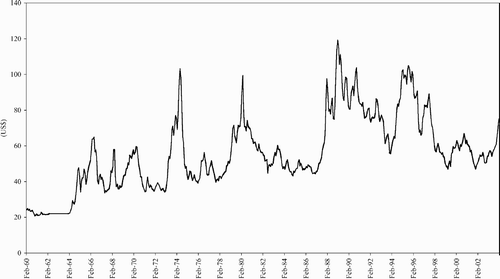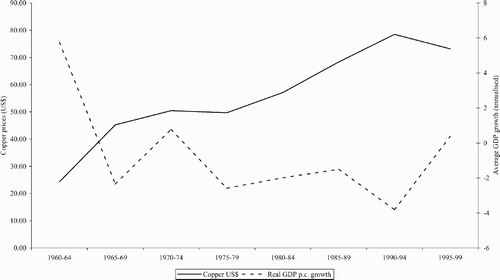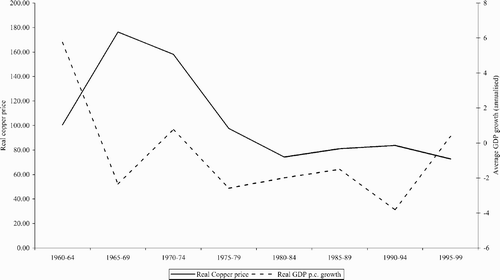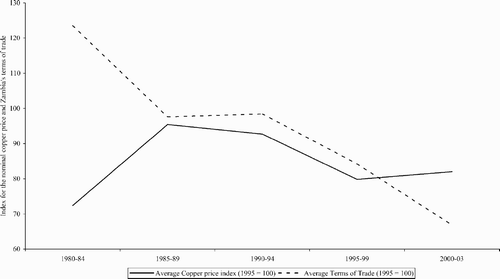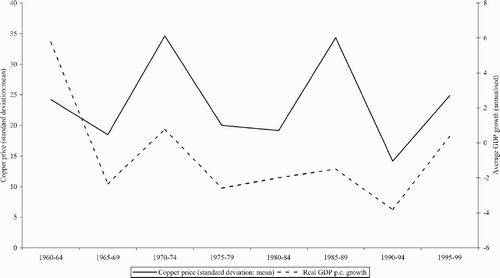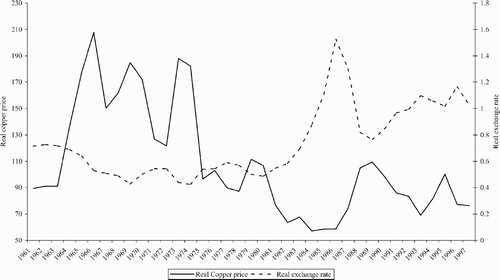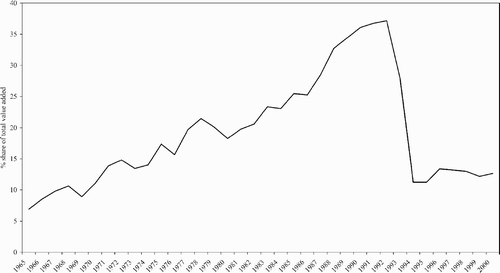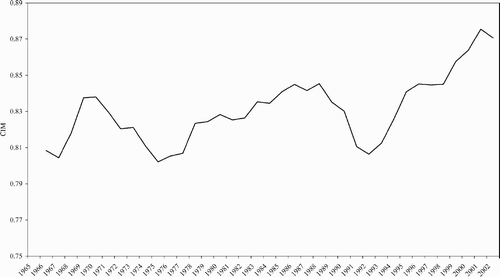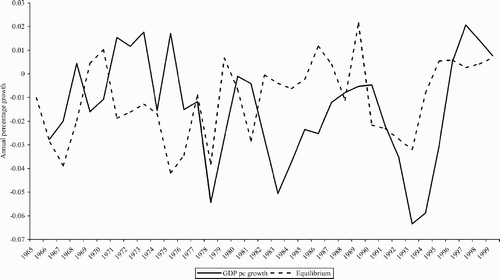Abstract
Zambian growth failure is often related to the resource curse. This article evaluates not only this claim, but also whether the new institutional theory can account for Zambia's economic decline. Little empirical support is found for the terms of trade or volatility versions of the resource curse theory, and there is only slightly more support for relative price versions of the theory. Turning to the new institutional theory, the article quantifies the poor quality of institutions in Zambia using a measure for contract intensive money, and supports the hypothesis that ‘poor quality’ institutions, and especially the failure to protect property and contract rights, played an important role in Zambia's economic decline. Examples are given to support this claim.
1. Introduction
The economic history of Zambia since the 1960s is a doleful tale; indeed, Murshed Citation(2002) listed Zambia among countries that have suffered catastrophic growth failure. Unravelling the causes of this decline is of great practical importance to Zambians (and residents of other similarly situated countries). A plausible account of these causes might also guide institutional and policy decisions in Zambia, with the hope of a higher growth path in the decades ahead.
This article evaluates the most likely of two rival explanations for economic decline in Zambia; that is, the resource curse on the one hand, and the new institutional theory on the other. Section 2 of this article contrasts the resource curse theory with the new institutional theory, as rival accounts of Zambia's economic decline. Section 3 provides empirical evidence relevant to these hypotheses. In doing this exercise the aim is not to test the general applicability of any of these theories, but rather to use evidence from the case study of the Zambian economy to evaluate how these two theories relate to this particular situation. In the concluding section the authors argue that empirical evidence supporting the new institutional theory suggests that accounts of Zambia's economic decline that focus on the resource curse without major emphasis on the importance of the development of Zambian institutions are barking up the wrong tree. This result is of practical importance as institutional development is endogenous in a way that resource dependence is not.
2. Two rival theories of economic decline
2.1 The resource curse
The resource (or winner's) curse refers to the surprising observation that countries with rich endowments of natural resources have suffered from disappointingly modest economic growth, or even economic decline (see ). An expanding literature grapples with the empirical robustness of this observation and the various theories that might explain it, including Auty (Citation1990, Citation2001), Gelb Citation(1988), Gylfason, Hertbertsson & Zoega Citation(1999), Robinson, Torvik & Verdier Citation(2002), Ross Citation(1999), Sachs & Warner (Citation1995, Citation1999, Citation2001), Sala-i-Martin & Subramanian Citation(2003), Sarraf & Jiwanji Citation(2001), Stijns Citation(2001) and Tornell & Lane Citation(1999).
Table 1: Relative performance of resource rich countries
Zambia features in much of this literature as a typical example of a country that is heavily dependent upon a rich endowment of natural resources and that has nevertheless suffered a disastrous economic decline in recent decades. Zambia has large copper reserves and copper had long accounted for upwards of 90 per cent of export revenue for Zambia (Murshed, Citation2002: ). However, copper's share of exports declined steadily through the 1990s, reaching around 60 per cent for the period 2000–2003 (IMF, Citation2004).
Table 2: The level and volatility of the copper price over time
The Zambian case is especially interesting because of the remarkable contrast between Zambian growth performance and that of its south-westerly neighbour, Botswana, which not only seems to have avoided the resource curse, but has been one of the fastest-growing countries internationally since the 1960s. Over the four decades since 1960, real per capita GDP (using the chain price method) declined by a quarter in Zambia, while it rose almost eightfold in Botswana over the same period (Heston, Summers & Aten, Citation2002).
Resource curse theories explain the disappointing growth of countries such as Zambia by arguing that exploiting the resource endowment crowds out other important decisions (investment in human capital, for example), which are known to have a positive impact on the process of economic growth (Sachs & Warner, Citation2001). There are, consequently, a number of rival versions of the resource curse hypothesis, drawing on the various rival theories of economic growth, including: terms of trade theories (discussed in 2.2) and relative price effect theories such as ‘Dutch disease’ (discussed in 2.3). The authors will treat institutional theories as an alternative hypothesis in Section 2.4, although it is highly likely that the problems associated with the resource curse might be mediated through poor quality institutions. The reason for treating these complementary hypotheses as rivals is that the problems of poor institutional quality are not restricted to resource rich countries, nor is there a necessary link between resource abundance and poor institutions. The difference between the two sets of theories is emphasised to underline the possible contribution of the new institutional literature to our understanding of Zambia's economic decline.
2.2 Terms of trade theories
A first group of theories supporting the resource curse hypothesis builds on the work of development economists Prebisch (for example, Citation1950) and Singer (for example, Citation1950). They argued that the price of primary commodities was expected to decline relative to the price of industrial goods and in this way provided support for inward industrialisation as a development strategy. In the case of Zambia, this version of the resource curse would hypothesise a link between the trend in international copper prices and the trend in growth of the economy, mediated by Zambia's terms of trade. Indeed, Zambia's declining terms of trade is often connected with the copper price in explanations of Zambia's economic decline (for example, Sachs & Warner, Citation1995; Stevens, Citation2003; Neumayer, Citation2004).
A second group of theories built around the terms of trade suggest that it is not the trend, but the volatility, of commodity prices, which translates into detrimentally volatile terms of trade (Bleaney & Greenaway, Citation1993; Aron, Citation1999; Sala-i-Martin & Subramanian, Citation2003). Such volatility, it is argued, creates uncertainty for business and government, lowering investment and undermining prudent fiscal management. Certainly the unsettling impact of volatile commodity prices on the business cycle in developing countries has been well established (for example, Agénor & Montiel, Citation1999) and this version of the resource curse theory extends the logic to the economy's growth path.
2.3 Relative price theories
Adverse terms of trade developments provided the dynamic for the resource curse theories in the previous section. An influential alternative is to develop a resource curse-type theory around relative price changes between the traded and non-traded goods sectors, usually in a model where the traded goods sector is subject to an external shock. Dutch disease models are well-known examples of the latter and postulate that a positive shock to the output price of the traded goods sector will lead to a real appreciation of the currency, so undermining the competitiveness of, notably, the traded goods sector domestically. The mechanism is as follows. A booming resource sector raises the demand for both traded and non-traded goods domestically (through a wealth effect). An appreciating real exchange rate causes a relative price effect domestically, in favour of the non-traded goods sector and against the traded goods sector. This price effect leads to a re-allocation of labour and capital from the traded to the non-traded goods sector, as was first observed in Holland during the 1960s and which might, in extreme cases, lead to de-industrialisation. In Krugman's well-known 1987 model the result is a permanent loss of competitiveness for the domestic traded goods sector, which leads to specialisation in the less dynamic non-traded goods sector (Matsen & Torvik, Citation2003).
Zambia's dependence on copper is of a kind that raises the likelihood of such distortionary relative price changes. Murshed Citation(2002), like Auty Citation(2001) and Woolcock, Pritchett & Isham Citation(2001), emphasises that the ‘kind’ of natural resource endowment might contribute more to the resource curse than a resource endowment as such. By ‘kind of endowment’, Murshed Citation(2002) distinguishes between endowments that are concentrated (an extractive industry, for example, with few backward and forward industrial linkages) and those that are diffuse, such as a natural resource endowment of fertile agricultural land. Zambia's copper endowment is typical of a concentrated natural resource endowment, which led Murshed Citation(2002) to classify Zambia with point-sourced economies, as opposed to resource-rich, but diffuse economies. As a stylised fact there are few point sourced resource rich economies that have avoided economic decline in recent decades, with Botswana as a notable exception.
2.4 New institutional theories
Whereas the preceding two groups of theories supporting the resource curse traced the domestic impact of an external event, falling or volatile prices, for example, this section introduces an endogenous theory where the focus is on responses within the public and private sector to the shocks associated with natural resource endowments. Since these decisions by the private and public sector are made within the constraints set by the formal and informal institutions in an economy – the subject matter of new institutional economics – this variation of the resource curse theory is treated in a separate sub-section drawing on the new institutional economics.
An analysis of the institutions in resource rich countries is complementary to the existing literature on the resource curse. The specific contribution of the new institutional economics literature in this area is to consider mechanisms through which the resource curse operates and to suggest ‘poor quality institutions’ as an important alternative channel (for example, to the real exchange rate) for the resource curse.
Robinson, Torvik & Verdier Citation(2002), for example, divided resource abundant countries into two groups: those that suffer from the resource curse and those that have apparently escaped it. They found a correspondence between the latter group and countries with favourable ratings on the institutional quality index, suggested by Knack & Keefer Citation(1995). This is consistent with an argument that resource abundance might be translated into sustained growth and development if the extractions are mediated through ‘good institutions’, while ‘poor institutions’, combined with natural resource abundance, lead to economic decline. Content can be given to terms such as ‘good’ and ‘poor’ institutions by drawing on the new institutional economics literature.
New institutional economics focuses the attention of growth theorists on the decisions and constraints on these decisions that set the contours for economic development. ‘The real secret of successful development is the performance of the people concerned’, as David Landes wrote, ‘…but achievement must come from within’ (Landes, Citation2003: 562). In Landes's view, economic development requires a certain kind of society; a society where many (perhaps most) people can envisage a better future, not only for themselves, but especially for their children (see also Lucas, Citation2002). But here is the crux: the path to this better future must pass through production, not predation; making new wealth, not merely diverting wealth from others (Knack, Citation2003).
A complex network of institutions – also called the institutional matrix – provides the backdrop for all social interaction, whether productive or predatory (North, Citation1984, Citation1990, Citation1991). This matrix comprises both formal rules (for example, the legal code) and informal rules (for example, customs and taboos) and is both political (for example, proportional representation as a voting rule) and economic (for example, tariffs).
These institutions might facilitate specialisation and exchange; when they lower transaction or contracting costs, or render behaviour more stable and predictable. In the words of Kasper & Streit Citation(1998), ‘…the key function of institutions is to facilitate order: a systematic, non-random and therefore comprehensible pattern of actions and events’. The definition and maintenance of property rights is a crucially important institution that has the effect of lowering transaction costs (North, Citation1991). Indeed, without property rights a whole class of transactions – especially those associated with the accumulation of private capita – is almost certainly excluded.
Mancur Olsen (Citation2003 [1996]) has argued that studying institutions helps us to untangle some of the puzzling stylised facts of economic growth. For example, that poor countries would not, unconditionally, be catching up with the rich countries, but that some poor countries–those with favourable institutions, creating adaptive efficiency – would enjoy catch-up growth. This is not a circular argument, with Olsen and others defining ‘good institutions’ as those institutions found in rich or fast growing countries. On the contrary, it is a positive theory of social change that yields empirically testable hypotheses (using various measures of institutional quality). In the next section the new institutional economics insights are used to illuminate another puzzling stylised fact, the economic decline of resource abundant Zambia.
3. Empirical evidence
In keeping with the explicitly empirical focus of this article, the authors confronted the various versions of the resource curse theory introduced above with Zambian data, in order to investigate the extent to which the economic decline of Zambia might be attributable to one or more of the theoretical mechanisms.
3.1 Terms of trade theories
Examining copper price variations and determining its connection with economic growth in Zambia would be one way of testing the empirical relevance of this theory. shows the international copper price (as determined on the London Metal Exchange) since the 1960s.
It is very difficult to identify a plausible trend in the time series of the copper price shown above. This is not only true of copper prices, but of metal prices in general, as Bleany & Greenaway observed using time-series data back to the early decades of the 20th century. Their evidence suggested that ‘…metal prices have simply followed a random walk, without a post-1980 fall’ (Bleany & Greenaway, Citation1993: 356).
shows the five-year averages of copper prices, indicating both nominal and real prices (with the latter deflated by the United States' producer price index as a relevant measure of international industrial prices). The table also shows the five-year standard deviations of nominal and real copper prices scaled by the five-year averages. These ratios are high (rarely below 20 per cent), confirming for copper what Bleaney & Greenaway found for an index of metal prices, that ‘…over any reasonable policy horizon long-term trends are dwarfed by fluctuations, implying that the trend is unlikely to be economically (as opposed to statistically) significant’ (Bleany & Greenaway, Citation1993: 360).
and explore the connection between nominal and real copper prices and real per capita GDP growth. Average GDP growth rates were calculated from the Penn World Table version 6.1 using the real GDP per capita calculated with the chain series method.
Neither of these figures suggests any significant relationship between the movements in the copper price and the growth rate of real per capita GDP. The relationship between the copper price and the terms of trade in Zambia as a direct test of the Prebisch – Singer hypothesis is considered as a final empirical observation. Regrettably, terms of trade data are sparse for Zambia on a consistent time series, but uses recent IMF data (IMF, Citation2004) to plot Zambia's terms of trade against the copper price in five-year averages since the early 1980s.
does not support the hypothesis that copper price fluctuations have dominated the terms of trade for Zambia. Indeed, it was only from 1985 to 1999 that the copper price and Zambia's terms moved in the same direction (for five-year averages).
There appears to be little support for the terms of trade theories based on the trend of copper prices leading to investigation of the volatility version of the terms of trade theories. The possibility that this volatility could have affected long-term growth in Zambia is explored in , which plots real GDP per capita growth against the standard deviation of the copper price for comparable five-year intervals. The figure shows only the standard deviation of the nominal copper price, as this series is highly correlated with the standard deviation of the real copper price.
does not support the theory that the economic decline of Zambia could principally, or even importantly, be traced to the volatility of the copper price if the relationship is assumed to take effect within a five-year horizon. Indeed, any relationship that seems to exist between copper price volatility and GDP growth is the opposite of what is suggested by that theory. However, it is conceivable that the debilitating effect of volatility would operate with a very long time period (in excess of five years), in which case might be reinterpreted as supporting the volatility version of the resource curse. The volatility of copper prices might have had another pernicious long-term impact in Zambia, however. Given the fiscal importance of copper revenues, the volatility of copper caused severe problems for fiscal management. Very optimistic forecasts of the copper price–some of these by the World Bank (Bigsten & Kayizzi-Mugerwa, Citation2000)–combined with a narrow tax base and the ratchet effect of government expenditure to create an ever-worsening fiscal situation.
provides additional information relevant to the volatility version of the resource curse theory, by comparing the volatility of copper prices with the volatility of other metals traded on the London Metal Exchange. The data in show that the copper price has not been exceptionally volatile when compared with the prices of other metals. This is not a claim that the price of copper has not been volatile – it clearly has, as was demonstrated above – but it has been less volatile than many other metal prices. Of course, it might be that all metal prices have been debilitatingly volatile, but that would be a much stronger claim than the proposition that copper prices have been destructively volatile.
Table 3: Volatilitya of copper and other metal prices
The evidence presented in this section is not meant to deny the obvious importance of the copper industry, and hence the copper price for the Zambian economy, but it does indicate that the relationship between the copper price, the copper industry in Zambia and ultimately the economy, is more complex than would be suggested by terms of trade versions of the resource curse hypothesis alone.
3.2 Relative price theories
To confront the relative price version of the resource curse with empirical evidence, two predictions are tested here. First, if Zambia was subject to Dutch disease then there should be an equilibrium relationship between the real copper price and Zambia's real exchange rate. Secondly, if the relative price effect of the traded goods sector in this point-sourced economy had an adverse effect on the traded goods sector we would expect to see a decline in the relative share of total output by the agricultural and industrial sectors relative to the mining and tertiary sectors, and this sectoral shift would be mediated by the real exchange rate fluctuations.
The first prediction, of positive equilibrium relationship between the real exchange rate and the real copper price, was tested with a multivariable cointegration test. A standard Johansen cointegration test was used to investigate the possibility of a stable long-term relationship between Zambia's real exchange rate and the real copper price. shows the tests statistics for the trace and maximum eigenvalue tests to determine the number of (cointegrating) long-term relationships (if any). Neither of these tests identify a rank for the long-term matrix greater than zero; that is, there is no evidence of a long-term relationship between the variables.
Table 4: Cointegration tests for the real exchange rate and real copper price
does not show any evidence of cointegration between these two variables a result which can also be confirmed visually in .
does not support the prediction of a real exchange rate driven by the variations of the real copper price. Other plausible factors that might account for the variation in Zambia's real exchange rate include the strategy of import substitution which had been pursued with increasing vigour through the 1970s (and would be consistent with the real appreciation observed during that decade) and the monetary mismanagement of the 1980s (which would be consistent with the real depreciation observed during that decade).
The second prediction of the relative price theories concerned the evolution of various sector shares in Zambian output. shows the evolution of value added by the manufacturing sector in Zambia as a proportion of GDP since the mid-1960s. There is no evidence of any influence of the nominal or real copper price on the share of manufacturing in Zambia. It is likely that this reflects the large degree of government planning in the Zambian economy, which had been pursued as part of the overarching socialist ideology of the Zambian government since the 1960s. Also, the precipitous collapse of domestic industry during the early 1990s was due to the eventual withdrawal of the large-scale subsidies and other fiscal support for industrial parastatals.
However, at the time of independence, agriculture (not industry) was Zambia's leading traded goods sector, apart from mining. Aron Citation(1999) regarded the stagnation of agriculture (observed by her in declining export revenue, but also observable in stagnating value added per hectare from the mid-1970s to the mid-1980s) as possible evidence of Dutch disease. However, she adds that the political climate (with the government supported by a food-subsidised urban constituency) and agriculture dominated by gloomy expatriate-dominated producers, combined transport and pricing problems to add to this stagnation. With such a confluence of debilitating factors it is difficult to identify Dutch disease as having had a primary impact on the agricultural sector. It is especially difficult to identify in the stagnation of Zambian agriculture with Dutch disease absent, the mediating role of an appreciating real exchange rate as postulated by the theory of Dutch disease.
The relative growth of the tertiary sector (by 50 per cent from 1965 until 1976) is consistent with the Dutch disease predictions; that is, a boom in the non-traded sector domestically and also in construction. However, Aron Citation(1999) argues that booms in construction and in services were led by government demand, and in both cases price distortions by government exacerbated the relative price effect associated with Dutch disease (Aron, Citation1999). The same identification problems associated with the stagnation in agriculture are present here and undermine the identification of the relative rise in the services sector with the expected symptoms of Dutch disease.
While the first test in this section did not uncover evidence of Dutch disease through the real exchange rate, the second did find outcomes consistent with the predictions of Dutch disease in relative sectoral prosperity and decline. However, the identification of these sectoral shifts with Dutch disease is undermined by two factors: first, the absence of any connection between the copper price and the real exchange rate of Zambia and, secondly, the other factors that had a direct impact on the sectors concerned (such as price controls on agricultural products) that have observationally equivalent predictions about sectoral shifts.
3.3 Institutional theories
The contemporary literature offers an abundance of attempts to quantify institutions in order to test the veracity of the new institutional theory (for example, Knack & Keefer, Citation1995). However, Aron Citation(2000) and Temple Citation(1999) have cautioned against optimistic assumptions that these measures would necessarily correspond with the institutions described by new institutional economics theory. Indeed, Aron Citation(2000) found the measures so varied that she proposed a five-category classification to group those measures which were conceptually related. Her classification included: first, measures of institutional quality; secondly, measures of social capital; thirdly, measures of social characteristics; fourthly, features of the political institutions; and, finally, measures of political instability (Aron, Citation2000).
Aron Citation(2000) drew a further distinction between subjective and objective measures within these categories. The observation that the respondents to a survey on institutional quality may be influenced by outcomes in the economy concerned (scoring successful economies high on the protection of property rights and failing economies low) is a major objection to the subjective measures. If such biases should occur systematically, then the subjective indices would pre-judge one of the most important issues that economists wish to test with the measures of, for example, property rights protection; that is, the causal connection between the protection of property rights and economic growth and development.
Clague et al. (for example, Citation1996, Citation1999) recently proposed an objective measure of the security of property rights with the added merit of using widely available data going back many decades for most countries (even developing countries where alternative data are sparse). The argument in Clague et al. (Citation1996, Citation1999) is that the assets used as money in an economy provide a convenient window on the protection of property rights and on third-party contract enforcement. Currency (notes and coins outside the banking sector) is the preferred medium of exchange in countries where contract enforcement is weak and property rights insecure. At the other extreme, in countries with very secure property rights and efficient and unbiased contract enforcement, money balances are most likely to be held in banks and in the form of other financial instruments. The proportion of liquid assets portfolios held as money in an economy might therefore be an objective measure of two important dimensions of ‘good institutions’; that is, the degree to which property rights are protected and the degree to which transaction rights are enforced.
There are three reasons for the a priori plausibility of using portfolios of money balances to indicate the security of property rights and contract enforcement (Clague et al., Citation1999). First, depositors have to trust both the security of their right to their money balances held in the bank as well as the contract rights implied in depositing and withdrawing money. This cannot be assumed in an economy where neither contract nor property rights are secure. Secondly, financial intermediaries also depend on property and contract rights to invest their deposits profitably. The extent of intermediation is, therefore, likely to be influenced by the security of property and contract rights. Finally, in regimes where government regulations and prohibitions encourage black markets, where contract enforcement may be problematic – for example in foreign currency, or credit – currency provides highly valued discretion.
Clague et al. (Citation1996, Citation1999) therefore introduced the concept of contract-intensive money (CIM), which is the ratio of non-currency money to the stock of broad money, or formally:
A higher relative value of the CIM indicates more secure property rights and contract enforcement. Further, a rise or fall in the CIM at all levels indicates a rise or decline in the relative security of these rights. Clague at al. Citation(1999) traced the impact of well-known political and economic events on the CIM in Iran, Turkey, Chile, Grenada, Indonesia and Brazil to verify the plausibility of the measure. They followed this episodic investigation with more formal econometric tests to show that CIM was correlated with other widely used measures of good institutions and good governance and that CIM was positively associated with growth and investment.
Since Clague et al. Citation(1999) proposed CIM as a measure of contract and property rights – and not as a measure of financial sector development – it was important to investigate the extent to which their results were driven by the level of financial sector development, inflation or savings rates. Clague at al. Citation(1999) provided formal econometric evidence that differences in CIM were not driven by financial sector development, inflation or the savings rate.
We calculated the CIM for Zambia to test the institutional theory of economic decline in Zambia. The prediction of that theory is that undermining property and contract rights would lead to stagnation or even decline economically. While no single-figure index can hope to capture the complexity of the institutional matrix, the argument here–following Claque et al. (1999) – is that the CIM captures an important aspect of that matrix, with valuable objective information about the protection of contract and property rights. The three-year centred moving average of the CIM for Zambia is plotted in .
Zambia's CIM indicates an erosion of property and contract rights (as measured) during the mid- to late 1970s and again a decade later. Zambia's per capita GDP contracted alarmingly during both of these periods. The first setback in property rights protection of the 1970s can be associated with various episodes of nationalisation. Nationalisations were used to serve the end of Zambianisation in the economy and were set in motion in April 1968 at Mulungushi, where President Kaunda proposed measures that permitted government to acquire 51 per cent shares in private retail, transport and manufacturing firms through a parastatal, INDECO (the Industrial Development Corporation). The government bought out 24 large private companies that were mainly involved in production and distribution throughout the country.
President Kaunda announced further nationalisations during a famous speech at Matero in August 1969. First, the Mines and Mineral Act of 1969 provided for the reversion of all mineral rights to the president on behalf of the state (Pettman, Citation1974: 127); and the government purchased 51 per cent shares from the mining companies, leading to partial nationalisation of the copper industry. The process was intensified in November 1970, when the government acquired a 51 per cent share in the private banks, took over all building societies and closed down all insurance companies, except the state's insurance company.
Further, and more subtle, infringements of property rights also occurred. At least six important tax and institutional changes were enacted between 1964 and the early 1970s, aimed at taxing windfall revenue and gaining more control over the mining sector. For example, after the referendum in 1969, the Zambian government changed the royalty and tax system in such a manner that the total tax on mining profits was 73 per cent. Aron Citation(1999) describes this tax as close to expropriation and one which provided little incentive for expansion in the mining sector.
During the late 1980s unsound money (high and variable inflation) undermined effective property and transaction rights. This was followed by the eroding effect of the increased political violence before the Kaunda reign was ended with the inception of the Third Republic in 1992. However, also suggests that the reforms of the 1990s have had a salutary impact on property and contract rights. If the theory is correct, this is predicted to have a positive impact on the growth in Zambia, if sustained.
In addition to the informal analysis above, we tested the combined CIM–new institutional economics theory by considering a Johansen cointegration test, which indicated that the CIM and GDP per capita growth in Zambia was cointegrated over the sample. This is confirmed visually in , which shows the growth in Zambian GDP per capita, together with the equilibrium value for per capita GDP growth as defined by the cointegrating relationship between GDP per capita growth and CIM (shown in ). shows the test statistics used to determine whether the variables cointegrate. The cointegration test was performed over a sample of annual data from 1967 to 2000. The initial unrestricted model contained two jointly endogenous variables (GDP per capita growth and CIM) both with two lags. The constant was restricted to the cointegrating space.
Table 5: Cointegration tests for GDP p.c. growth and CIM in Zambia
Table 6: Restriction tests on the cointegrating relationship
Further restrictions of the long-term relationship were tested, including tests of the significance of the components of the long-term relationship, a weak exogeneity test for CIM and a Granger causality test (in ). The weak exogeneity of CIM in the relationship combined with the Granger causality from CIM to GDP per capita growth means that CIM is strongly exogenous in the estimated relationship (Hendry, Citation1995: 170–1). This result implies that, statistically speaking, the direction of influence is from CIM to GDP growth. These results are reported with the resulting long-term relationship in and . The long-term relationship estimated with a reduced rank regression after assuming (from the evidence in ) that there is one cointegrating vector and, from the tests reported in , that CIM could be modelled as weakly exogenous in this case.
Table 7: Granger causality tests
In the light of the inevitable inadequacy of any one institutional measure, it is encouraging to find that other widely used indices, for example the Frasier Institute index of economic freedom (Gwartney & Lawson, Citation2003), show a similar pattern for Zambia. Although Zambia experienced slight gains in economic freedom (both relatively and absolutely) during the late 1970s, this trend was dramatically reversed with sharp absolute declines in economic freedom during the 1980s, and this against a background of improving economic freedom over the same period (on average) internationally. When combined, the evidence of these various measures suggests that the new institutional theory might make an important contribution towards understanding the economic decline of Zambia.
4. Conclusion
In this article the authors have contrasted versions of the resource curse hypothesis as explanations for the economic decline of Zambia since the 1960s. The empirical evidence in the second section offered little support for terms of trade or volatility theories of the resource curse in Zambia. There was somewhat more evidence for the relative price versions of the theory, especially Dutch disease, although the effect of the latter is difficult to identify in the absence of the expected exchange rate effect and due to other interventions with similar predicted sectoral shifts.
Sub-section 3.3 presented evidence in support of an alternative version of the resource curse, focusing on the institutional framework within which such external disturbances have to be absorbed. The evidence in that sub-section is consistent with the hypothesis that ‘poor quality’ institutions, especially the failure to protect property and contract rights, played an important role in Zambia's economic decline. Naturally, a comprehensive picture of Zambia's economic decline would, in addition to an institutional evaluation and considerations of Dutch disease, add an analysis of other factors which have affected economic growth in other countries: the investment rate, the rate of population growth, the accumulation of human capital and financial sector development and openness (especially to international trade). Zambia's experience along these dimensions has also been consistent with Zambia's disappointing economic performance. The long-term relationship estimated that, with a reduced rank regression after assuming (from the evidence in ) that there is one cointegrating vector, and from the tests reported in , CIM could be modelled as weakly exogenous in this case. These factors and the institutional analysis jointly undermine the hypothesis that Zambia's decline was due mainly to the dependence on copper; rather, the dependence on copper exacerbated the impact of poor quality institutions on the growth path of Zambia.
References
- Agénor , PR and Montiel , PJ . 1999 . Development Macroeconomics, , second edition. , Princeton : Princeton University Press .
- Aron , J . 1999 . A recent history of Zambia's management of copper price shocks , Oxford : SCAE WPS/1999-15 .
- Aron , J . 2000 . Growth and institutions: a review of evidence . The World Bank Observer , 15 ( 1 ) : 99 – 135 .
- Auty , RM . 1990 . Resource-based industrialisation: sowing the oil in eight developing countries , Oxford : Oxford University Press .
- Auty , RM . 2001 . Resource abundance and economic development , London : Oxford University Press .
- Bigsten , A and Kayizzi-Mugerwa , S . 2000 . “ The political economy of policy failure in Zambia. Working Paper in Economics no. 23 ” . Goteborg : Department of Economics, Goteborg University .
- Bleaney , M and Greenaway , D . 1993 . Long-run trends in the relative price of primary commodities and in the terms of trade of developing countries . Oxford Economic Papers , 45 : 349 – 363 .
- Clague , C , Keefer , P , Knack , S and Olson , M . 1996 . “ Property and contract rights in autocracies and democracies ” . In Democracy, governance and growth , Edited by: Knack , S . 136 – 180 . Ann Arbor : University of Michigan Press .
- Clague , C , Keefer , P , Knack , S and Olson , M . 1999 . “ Contract-intensive money: contract enforcement, property rights and economic performance ” . In Democracy, governance and growth , Edited by: Knack , S . 78 – 110 . Ann Arbor : University of Michigan Press .
- Gelb , AH . 1988 . Windfall gains: blessing or curse? , Oxford : Oxford University Press .
- Gwartney , JD and Lawson , RA . 2003 . Economic freedom of the world: 2003 annual report , Vancouver : Frasier Institute .
- Gylfason , T , Herbertson , TT and Zoega , G . 1999 . A mixed blessing: natural resources and economic growth . Macroeconomic Dynamics , 3 : 204 – 225 .
- Hendry , DF . 1995 . Dynamic econometrics , Oxford : Oxford University Press .
- Heston , A , Summers , A and Aten , B . 2002 . Penn world table , Center for International Comparisons at the University of Pennsylvania . version 6.1
- International Monetary Fund (IMF) . 2004 . “ Zambia: selected statistical issues and statistical appendix ” . Washington : IMF . Country Report no. 04/160
- Kasper , W and Streit , ME . 1998 . Institutional economics: social order and public policy , Cheltenham : Edward Elgar .
- Knack , S . 2003 . “ Predation or production? The impact of political, legal and social institutions ” . In Democracy, governance and growth , Edited by: Knack and S . 1 – 24 . Ann Arbor : University of Michigan Press .
- Knack , S and Keefer , P . 1995 . Institutions and economic performance: cross country tests using alternative institutional measures . Economics and Politics , 7 ( 3 ) : 207 – 27 .
- Krugman , P . 1987 . The narrow moving band, the Dutch Disease and the competitive consequences of Mrs Thatcher: notes on trade in the presence of dynamic scale economies . Journal of Development Economics , 27 : 41 – 55 .
- Landes , D . 2003 . The unbound Prometheus: technological change and industrial development in Western Europe from 1750 to the present, , second edition. , Cambridge : Cambridge University Press .
- Lucas , RJ . 2002 . Lectures on Growth Theory , Cambridge, MA : Harvard University Press .
- Matsen , E and Torvik , R . 2003 . “ Optimal Dutch disease ” . Trondheim : Norwegian University of Science and Technology . Department of Economics working paper series, no. 1/2003
- Murshed , SM . 2002 . “ On natural resource abundance and underdevelopment ” . The Hague : Institute of Social Studies (ISS) . Background paper for the 2003 World Development Report
- Neumayer , E . 2004 . Does the ‘resource curse’ hold for growth in genuine income as well? . World Development , 32 ( 10 ) : 1627 – 40 .
- North , DC . 1984 . Transaction costs, institutions, and economic history . Journal of Institutional and Theoretical Economics , 140 : 7 – 17 .
- North , DC . 1990 . Institutions, institutional change, and economic performance , Cambridge, MA : Harvard University Press .
- North , DC . 1991 . Institutions . Journal of Economic Perspectives , 5 ( 1 ) : 97 – 112 .
- Olson , M . 2003 [1996] . “ Big bills left on the sidewalk: why some nations are rich, and others poor ” . In Democracy, governance and growth , Edited by: Knack , S . 29 – 55 . Ann Arbor : University of Michigan Press .
- Pettman , J . 1974 . Zambia: security and conflict , UK : Julian Friedmann . Sussex
- Prebisch , R . 1950 . The economic development of Latin America and its principal problems , New York : United Nations .
- Robinson , J , Torvik , R and Verdier , T . 2002 . “ Political foundations of the resources curse ” . London : CEPR . CEPR Working Paper no. 3422
- Ross , ML . 1999 . The political economy of the resource curse . World Politics , 51 : 297 – 322 .
- Sachs , A and Warner , AM . 1995 . Natural resource abundance and economic growth , Boston, MA : NBER . NBER Working Paper no. 5398
- Sachs , A and Warner , AM . 1999 . The big push, natural resource booms and growth . Journal of Development Economics , 59 : 43 – 76 .
- Sachs , A and Warner , AM . 2001 . The curse of natural resources . European Economic Review , 45 : 827 – 38 .
- Sala-i-Martin , X and Subramanian , A . 2003 . Addressing the natural resource curse: an illustration from Nigeria , Boston, MA : NBER . NBER Working Paper no. 9804
- Sarraf , M and Jiwanji , M . 2001 . “ Beating the resource curse: the case of Botswana ” . Washington : World Bank . Environment Department Paper no. 24753
- Singer , HW . 1950 . The distribution of gains between investing and borrowing countries . American Economic Review (Papers and Proceedings) , 40 : 473 – 85 .
- Stevens , P . 2003 . Resource impact: a curse or a blessing? . The CEPMLP Internet Journal , 14 ( 1 ) : 1 – 35 .
- Stijns , J-P . 2001 . Natural resources and economic growth revisited Available at: http://papers.ssrn.com/sol3/papers.cfm?abstract_id=264878# (accessed May 2006)
- Temple , J . 1999 . The new growth evidence . Journal of Economic Literature , 37 ( 1 ) : 112 – 56 .
- Tornell , A and Lane , PR . 1999 . The voracity effect . American Economic Review , 89 ( 1 ) : 22 – 46 .
- Woolcock , M , Pritchett , L and Isham , J . 2001 . “ The social foundation of poor economic growth in resource-rich countries ” . In Resource abundance and economic development , Edited by: Auty , RM . 76 – 94 . Oxford : Oxford University Press .
